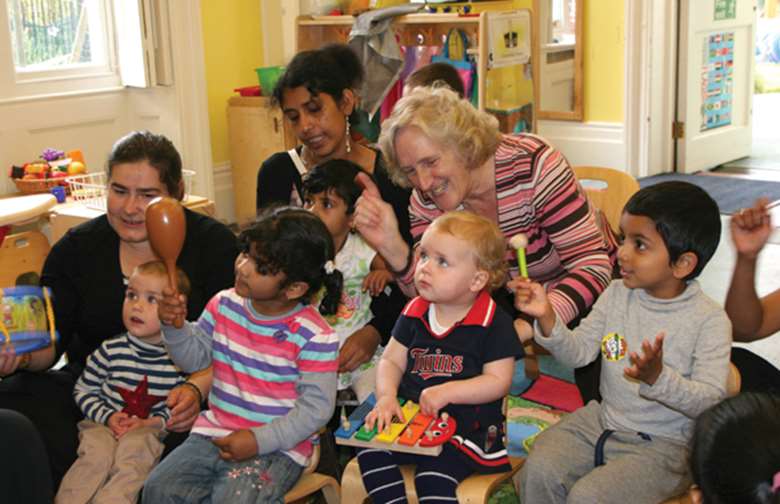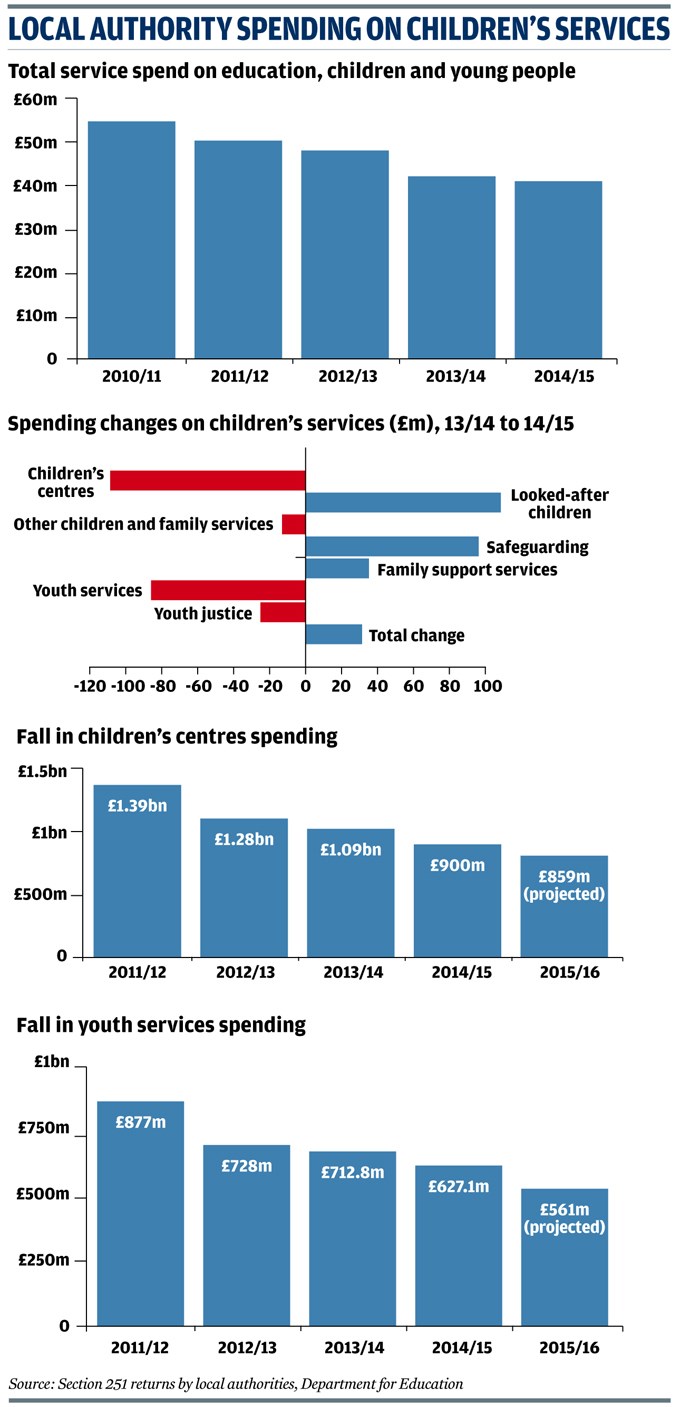Providers of children's centres look at new models to offset budget cuts
Jess Brown
Tuesday, January 5, 2016
As local authority data reveals a doubling of cuts in spending on children's centres, forcing them to prioritise the protection of statutory functions, a DfE report suggests that councils' ability to do this is being stretched to the limit.

Latest local authority data reveals the level of cuts in spending on children's centres has doubled over the past 12 months.
Section 251 returns from councils, published in December, show £900m was spent on children's centres in 2014/15, down from £1.1bn the year before (see graphic, below).
The depth of the cuts are a reflection of the pressure local authority budgets are under in light of rising demand and reduced government funding for all children's services over the past five years (see graphic, below).
Councils' response to this has been to prioritise protecting spending on statutory functions, such as services for looked-after children and safeguarding, at the expense of early intervention services, including children's centres and youth work (see graphic, below).
Despite this, most councils recognise the need to continue funding and delivering early help services, and have been looking at increasingly creative ways in which to reshape provision.
In some cases, centres have relinquished physical buildings in order to afford to retain their services. Others have shifted centres' focus away from universal towards targeted services.
However, findings from a recent Department for Education report suggest councils' ability to do this is beginning to be stretched to its limits.
The Changes in Resourcing and Characteristics of Children's Centres report, based on analysis of work at 117 sites, found those that had experienced cuts in staff and services had the highest number of users and were not adding any new services or reconfiguring existing ones.
The report also found that centres that had received a funding reduction were more likely to restructure, including moving away from standalone centres to other models such as "hub and spoke" arrangements where one centre or manager is responsible for a cluster of satellite centres.
In light of the tougher funding climate, children's charities have led the way in devising new ways of utilising children's centres.
Charity 4Children has put forward its Children and Family Community Hubs as a "game-changer" for public services.
The model is based around the idea of bringing together services including midwives, social care and youth services for children aged 0 to 19.
The charity says the centres would offer joined-up support across sectors. Each centre
would offer childcare, special educational needs support and a dedicated social care family worker.
It also sees children's centres as a place in which to deliver the government's Healthy Child and Troubled Families programmes.
Charity 4Children says targeted services should increase, while a baseline level of universal services is maintained.
Action for Children has proposed a slightly different model, with an emphasis on cutting running costs by reducing the number of buildings used and sharing facilities with other services, such as free childcare provision and health visiting.
Kate Mulley, director of policy and campaigns at Action for Children, says basing health visitors in children's centres "will prevent fragmentation of early help services and allow better integration".
"This is particularly important when budgets are tight because it will allow health visitors to refer earlier those families with a higher level of need that require more specialist services," she adds.
Action for Children's model emphasises the importance of prioritising universal services, especially up to the age of five.
Other models beginning to emerge aim to tap into existing community resources and the skills of local parents as a way in which to deliver provision more cheaply.
Derby Council has proposed that schools take over the ownership, management and running costs of seven children's centres that are on or near school sites. There is appetite from head teachers in all seven areas to this proposal, according to the council.
Parents' initiative
Meanwhile, in September, a group of parents in Staffordshire took over the running of two centres threatened with closure. The volunteers formed a community interest company, with the aim of applying for funding from local councils and charitable grants.
Jenny Coles, chair of the Association of Directors of Children's Services families, communities and young people policy committee, says it is important for councils to pick the model that best meets the needs of the local community.
"There is no set model of children's centre provision for children and families," she says.
"Local authorities are working closely with partners in the public, voluntary and community sectors, as well as parents and residents to support the delivery of these valuable preventative services. This is making efficiencies, reducing costs but also crucially enables a focus on families most in need.
"In one area there may be community groups or a local voluntary sector organisation running centres from libraries or attached to a health clinic. In another, a school may be the lead provider in a hub-and-spoke arrangement."
Coles adds that many areas are integrating health and youth services into the children's centres in an effort to better co-ordinate the prevention "offer" to families and provide services across the 0- to 19-year-old age range.
Mulley agrees with Coles that centres need to focus on a community's own needs.
"All models have benefits and drawbacks. What we need to focus on overall are those key programmes that work in different communities," she says.
"Local authorities should be held to account for the early years approaches they are taking, as measured through the outcomes they achieve for children and families."
Spending cuts are changing the status and structure of youth services, warn leaders
Section 251 returns by local authorities for 2014/15 show £627m was spent on youth services, down 12 per cent from £712m in 2013/14. This fall in spending continues a downward trend over the past five years that children's services leaders say is unlikely to abate over the rest of the decade (see graphic).
Paul Miller, interim chief executive at the National Youth Agency, says reduced levels of funding have "forced a revolution" in how youth work organisations deliver their work.
"That scarcity of funding has pushed the sector to seek creative solutions, using funding more efficiently and collaborating more widely than before, often with commercial organisations who make new and different demands."
Susanne Rauprich, chief executive of the National Council for Voluntary Youth Services, adds the spending fall will continue as local authorities focus scarce resources on funding services for the most vulnerable young people.
"Open-access youth work is most likely to suffer," she explains. This covers services such as youth clubs and sports projects. "We can see there are less grounds for organisations to deliver open-access youth work and that local authorities have virtually abandoned the delivery of open-access youth work themselves."
Adam Muirhead, chair of the Institute for Youth Work, says when funding is cut, commissioners tend to award contracts to providers offering to deliver services more cheaply. This "race to the bottom" will continue, he fears.
In addition to the outsourcing of services, Rauprich says cuts have impacted on the way council-run services are delivered, with authorities changing organisation structures to models such as staff-led mutuals.
She adds that the success of youth charity Onside and its youth zones is "quite interesting" because they are "a partnership initiative with the help of local authority investment" that also brings in businesses, parents and communities".
As council-run services have shrunk, many youth workers have lost their jobs or faced redeployment into other council teams. Muirhead says this has diluted youth workers' role and given rise to the perception they are "cheap social workers".
He adds: "Just a handful [of youth workers] will retain employment as something with youth work in their job title under a new spin-out trust structure.
"This appears to be fairly typical nationally, with different in-house services at different stages. But invariably youth work as a profession is diluted, rebranded or simply swept aside, which serves to undervalue our rich history, culture and values."
The NYA's Miller adds: "Youth work is becoming a specialism, with its skills used to supplement other services and target them at hard to reach young people." 




